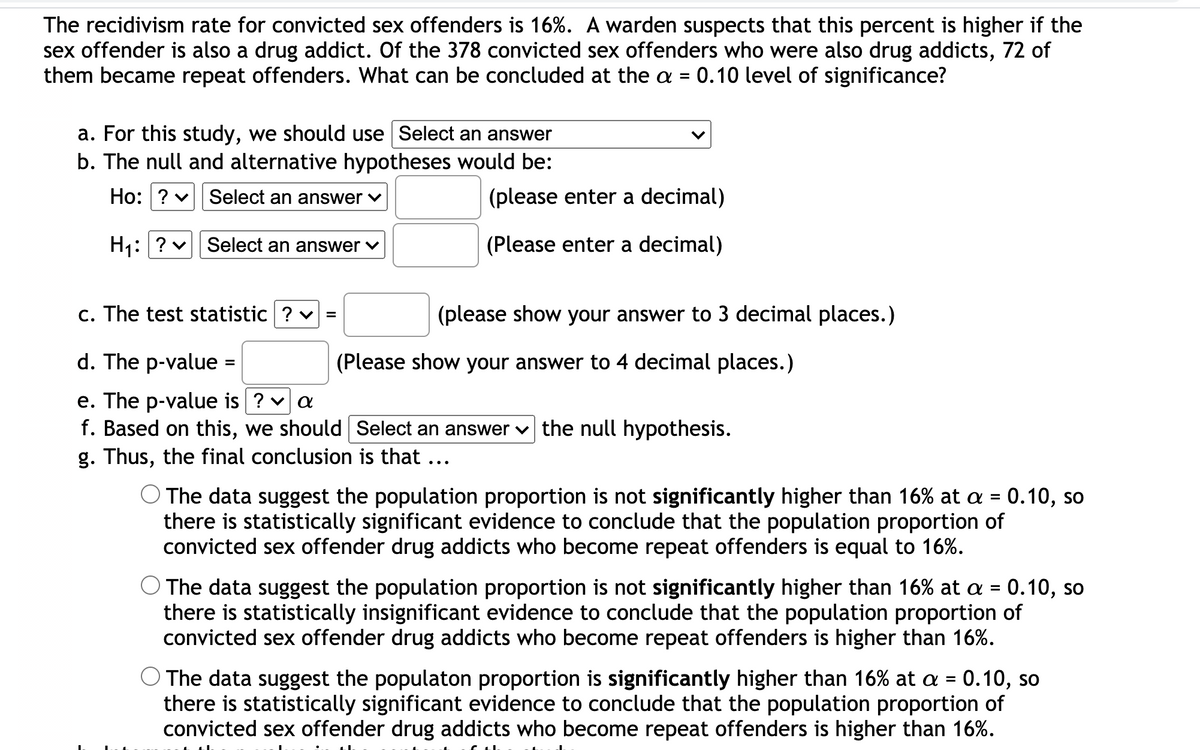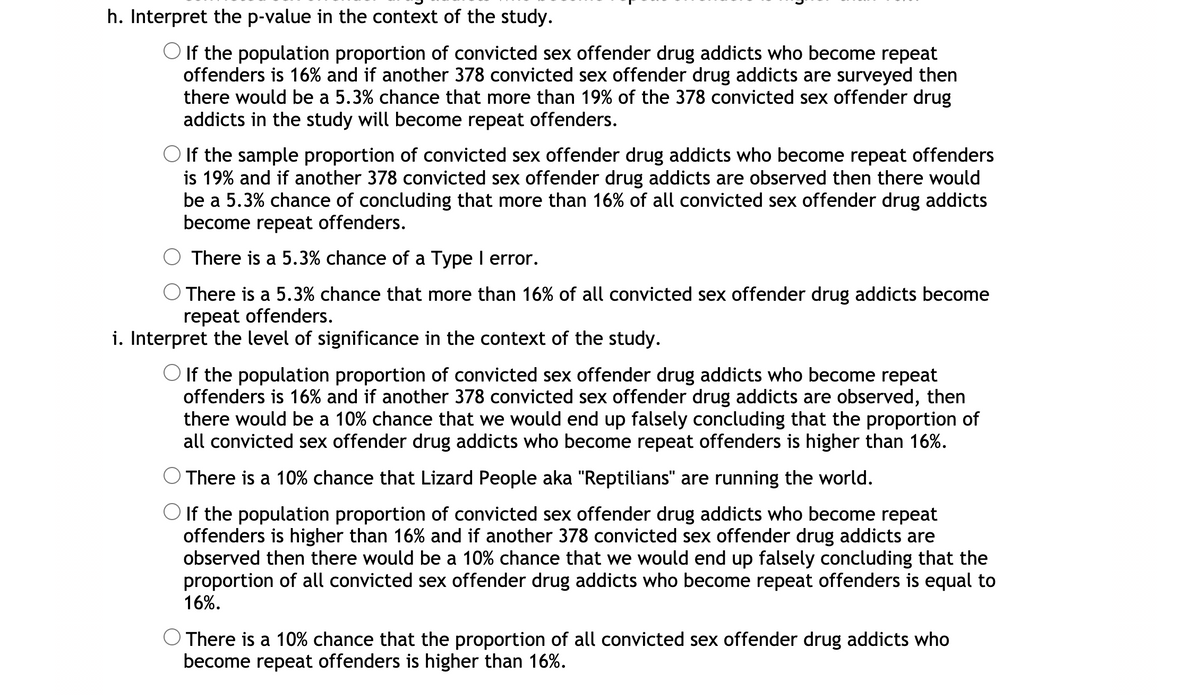The recidivism rate for convicted sex offenders is 16%. A warden suspects that this percent is higher if the sex offender is also a drug addict. Of the 378 convicted sex offenders who were also drug addicts, 72 of them became repeat offenders. What can be concluded at the a = 0.10 level of significance? a. For this study, we should use Select an answer b. The null and alternative hypotheses would be: Ho: ? v Select an answer v (please enter a decimal) H1:? v Select an answer ♥ (Please enter a decimal) c. The test statistic ? v = (please show your answer to 3 decimal places.) d. The p-value = | (Please show your answer to 4 decimal places.) e. The p-value is ? v a f. Based on this, we should Select an answer v the null hypothesis. g. Thus, the final conclusion is that ... The data suggest the population proportion is not significantly higher than 16% at a = 0.10, so there is statistically significant evidence to conclude that the population proportion of convicted sex offender drug addicts who become repeat offenders is equal to 16%. O The data suggest the population proportion is not significantly higher than 16% at a = 0.10, so there is statistically insignificant evidence to conclude that the population proportion of
The recidivism rate for convicted sex offenders is 16%. A warden suspects that this percent is higher if the sex offender is also a drug addict. Of the 378 convicted sex offenders who were also drug addicts, 72 of them became repeat offenders. What can be concluded at the a = 0.10 level of significance? a. For this study, we should use Select an answer b. The null and alternative hypotheses would be: Ho: ? v Select an answer v (please enter a decimal) H1:? v Select an answer ♥ (Please enter a decimal) c. The test statistic ? v = (please show your answer to 3 decimal places.) d. The p-value = | (Please show your answer to 4 decimal places.) e. The p-value is ? v a f. Based on this, we should Select an answer v the null hypothesis. g. Thus, the final conclusion is that ... The data suggest the population proportion is not significantly higher than 16% at a = 0.10, so there is statistically significant evidence to conclude that the population proportion of convicted sex offender drug addicts who become repeat offenders is equal to 16%. O The data suggest the population proportion is not significantly higher than 16% at a = 0.10, so there is statistically insignificant evidence to conclude that the population proportion of
Glencoe Algebra 1, Student Edition, 9780079039897, 0079039898, 2018
18th Edition
ISBN:9780079039897
Author:Carter
Publisher:Carter
Chapter4: Equations Of Linear Functions
Section: Chapter Questions
Problem 8SGR
Related questions
Question

Transcribed Image Text:The recidivism rate for convicted sex offenders is 16%. A warden suspects that this percent is higher if the
sex offender is also a drug addict. Of the 378 convicted sex offenders who were also drug addicts, 72 of
them became repeat offenders. What can be concluded at the a =
0.10 level of significance?
a. For this study, we should use Select an answer
b. The null and alternative hypotheses would be:
Ho: ? v Select an answer
(please enter a decimal)
H1:? v Select an answer
(Please enter a decimal)
c. The test statistic ? v =
(please show your answer to 3 decimal places.)
d. The p-value
(Please show your answer to 4 decimal places.)
e. The p-value is ? v a
f. Based on this, we should Select an answer v the null hypothesis.
g. Thus, the final conclusion is that ...
O The data suggest the population proportion is not significantly higher than 16% at a = 0.10, so
there is statistically significant evidence to conclude that the population proportion of
convicted sex offender drug addicts who become repeat offenders is equal to 16%.
The data suggest the population proportion is not significantly higher than 16% at a = 0.10, so
there is statistically insignificant evidence to conclude that the population proportion of
convicted sex offender drug addicts who become repeat offenders is higher than 16%.
O The data suggest the populaton proportion is significantly higher than 16% at a = 0.10, so
there is statistically significant evidence to conclude that the population proportion of
convicted sex offender drug addicts who become repeat offenders is higher than 16%.

Transcribed Image Text:h. Interpret the p-value in the context of the study.
O If the population proportion of convicted sex offender drug addicts who become repeat
offenders is 16% and if another 378 convicted sex offender drug addicts are surveyed then
there would be a 5.3% chance that more than 19% of the 378 convicted sex offender drug
addicts in the study will become repeat offenders.
O If the sample proportion of convicted sex offender drug addicts who become repeat offenders
is 19% and if another 378 convicted sex offender drug addicts are observed then there would
be a 5.3% chance of concluding that more than 16% of all convicted sex offender drug addicts
become repeat offenders.
There is a 5.3% chance of a Type I error.
There is a 5.3% chance that more than 16% of all convicted sex offender drug addicts become
repeat offenders.
i. Interpret the level of significance in the context of the study.
O If the population proportion of convicted sex offender drug addicts who become repeat
offenders is 16% and if another 378 convicted sex offender drug addicts are observed, then
there would be a 10% chance that we would end up falsely concluding that the proportion of
all convicted sex offender drug addicts who become repeat offenders is higher than 16%.
There is a 10% chance that Lizard People aka "Reptilians" are running the world.
O If the population proportion of convicted sex offender drug addicts who become repeat
offenders is higher than 16% and if another 378 convicted sex offender drug addicts are
observed then there would be a 10% chance that we would end up falsely concluding that the
proportion of all convicted sex offender drug addicts who become repeat offenders is equal to
16%.
There is a 10% chance that the proportion of all convicted sex offender drug addicts who
become repeat offenders is higher than 16%.
Expert Solution
Step 1
Given :
a)
For this study, we should use one-sample proportion test.
b)
Step 2
c) Test Statistic :
d)
P-value = 0.053
e)
f)
g)
Step by step
Solved in 3 steps

Knowledge Booster
Learn more about
Need a deep-dive on the concept behind this application? Look no further. Learn more about this topic, statistics and related others by exploring similar questions and additional content below.Recommended textbooks for you

Glencoe Algebra 1, Student Edition, 9780079039897…
Algebra
ISBN:
9780079039897
Author:
Carter
Publisher:
McGraw Hill

College Algebra (MindTap Course List)
Algebra
ISBN:
9781305652231
Author:
R. David Gustafson, Jeff Hughes
Publisher:
Cengage Learning

Glencoe Algebra 1, Student Edition, 9780079039897…
Algebra
ISBN:
9780079039897
Author:
Carter
Publisher:
McGraw Hill

College Algebra (MindTap Course List)
Algebra
ISBN:
9781305652231
Author:
R. David Gustafson, Jeff Hughes
Publisher:
Cengage Learning